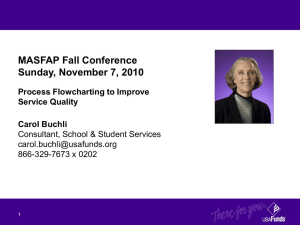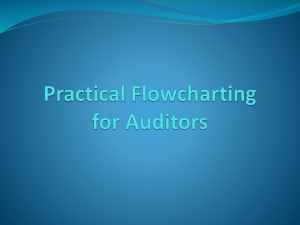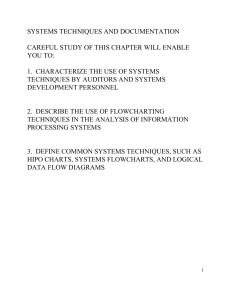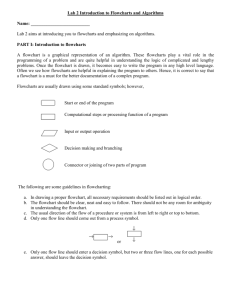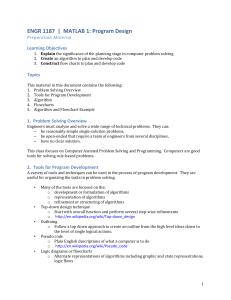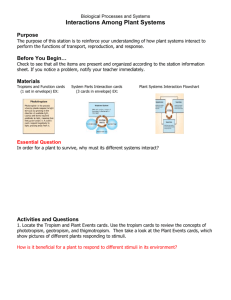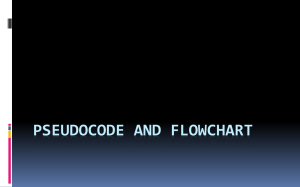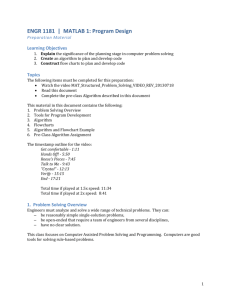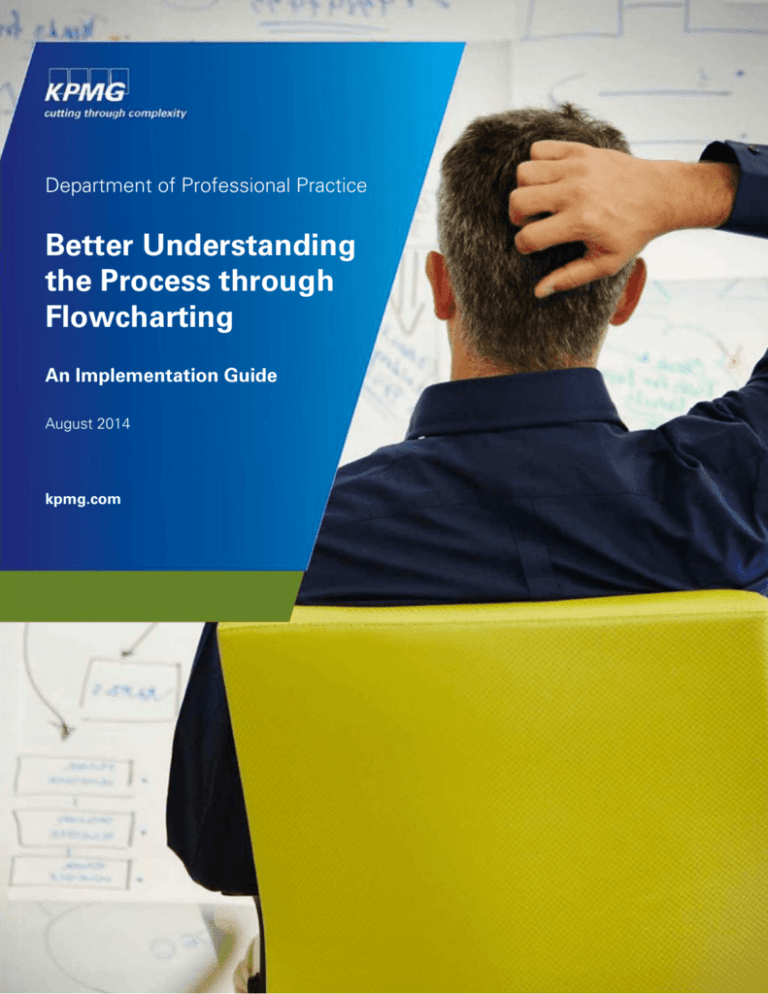
Department of Professional Practice
Better Understanding
the Process through
Flowcharting
An Implementation Guide
August 2014
kpmg.com
Better Understanding the
Process through Flowcharting
An implementation guide
Preface
A picture is worth a thousand words.
The efficiency expert Edward Deming once said: “Draw a flowchart for
whatever you do. Until you do, you do not know what you are doing, you
just have a job.”
Department of Professional Practice – An Implementation Guide (the
Guide) is designed to assist you in developing flowcharts as a tool to
enhance your understanding of the flow of information through your
entity’s processes and systems, the identification of likely sources of
material misstatements in the financial statements and the controls in
place to address those potential material misstatements.
The Guide is designed for use by management1 to help address the
requirements, needs and objectives for evaluating and assessing an
entity’s internal control over financial reporting in accordance with Section
404 of the Sarbanes-Oxley Act of 2002 and the COSO 2013 Framework
published by the Committee of Sponsoring Organizations of the Treadway
Commission (“COSO”).
This document is intended for informational and educational purposes and should not be used or relied
upon to ensure an entity has met or will meet its responsibility with respect to internal control over
financial reporting. Illustrations and guidance included within the Guide are designed to highlight key
concepts and are not intended to be comprehensive examples of all elements that you should consider
when obtaining an understanding of the respective process.
1
As this Guide has been designed for use by management, the use of terms such as “you” or “your” refer to employees or other
individuals within the entity responsible for internal control over financial reporting.
C O N T E N T S
Background and objectives
2 Introduction to flowcharting
4 Basic flowcharting conventions
4 Standard symbols
5 Developing flowcharts
8 Leverage available information and validate management’s understanding
8 Identify the key steps and activities in the process
8 Consider information systems
10 Challenge the flowchart
11 Potential questions to challenge the flowchart
11 Try not to:
12 Conclusion
13
Appendix – Example Flow Chart
2 | Department of Professional Practice – Implementation Guide
Background and objectives
Who should read this document?
KPMG has prepared this document for management and
members of corporate teams responsible for compliance with
Sarbanes-Oxley Act Section 404 compliance (SOX 404) and
COSO 2013.
Why is it important?
Management is responsible for maintaining a system of
internal control over financial reporting2 (ICOFR) that provides
reasonable assurance regarding the reliability of financial
reporting and the preparation of its external financial
statements. This includes maintaining evidential matter,
including documentation, to provide reasonable support for the
assessment of the system.
In its interpretive guidance, the SEC has noted that while the
evaluation of ICOFR will vary from entity to entity, “the
top-down, risk-based approach…will typically be the most
efficient and effective way to conduct the evaluation.” This
approach allows management to focus their attention and
efforts on the risks that address the potential sources of
material misstatement.
Flowcharting will assist management in accomplishing the
above in the most effective and efficient manner.
How can flowcharting help?
To properly identify risks, management must obtain an
understanding of the flow of information through the financial
reporting processes and IT systems. Our experience has
shown that a graphical depiction of the process (i.e., a
flowchart) provides the best means to demonstrate the flow
of information through a process and an IT system. It allows
multiple parties to review the same information and
understand the flow of information in basic terms from
different perspectives within the organization (process
owners, IT owners, etc.). It also allows for easier clarification
of gaps in controls and risk areas (What Could Go Wrong’s or
WCGW) that have not been previously identified. Once
management has gained an understanding of the flow of
information, it can identify the points in the process at which a
misstatement due to error or fraud could arise and would be
material—and the controls that have been implemented to
address the potential misstatements. Management can then
select controls at that point or after that point in the flow to
2
As defined in Auditing Standard No. 5 – An Audit of Internal Control Over Financial Reporting That Is Integrated with An Audit of Financial Statements.
Department of Professional Practice – Implementation Guide | 3
address the risks.
We believe that flowcharts are an extremely useful tool to
understand, confirm and document the flow of information.
Why is flowcharting better than a detailed narrative?
The flow of information is easier to understand in a visual
flowchart than in a long narrative. Flowcharts help:
Depict the flow of transactions: how they are initiated,
authorized, processed and recorded, including when
information flows between multiple systems which is a
common area where gaps are identified.
Identify the points within the entity’s processes at which a
misstatement – including a misstatement due to fraud –
could arise, that individually or in combination with other
misstatements could be material.
Identify the controls, including automated and IT
dependent application controls, that have been
implemented to address these potential misstatements.
Identify the controls that have been implemented over the
prevention or timely detection of unauthorized acquisition,
use or disposition of the entity’s assets that could result in
a material misstatement of the financial statements.
Provide management with the requisite documentation to
evidence their assessment of ICOFR.
Enable management to take a “fresh look” at the process
and controls in place, so that they can answer a number of
questions, including:
–
“Do we have the most efficient control structure?”
–
“Have we identified all the WCGWs?”
–
“Are there points where automated controls would
be more efficient and effective?;and
–
“Do our processes have redundant controls, and conversely, do we have all the WCGWs covered?”
Won’t flowcharting our processes take time and energy?
Converting narratives to flowcharts may take some initial investment. Our experience has shown that many existing
Company narratives have some level of deferred maintenance as processes change throughout the years but the
narratives haven’t been updated timely. Instituting a flowcharting process to (i) reconfirm the understanding of the
process, (ii) reconsider the appropriateness of the controls in place, and (iii) satisfy management’s responsibility to
perform risk assessment and fulfill their COSO documentation requirements will create a more effective program and
create efficiencies down the road. Once in place, a flowchart can more easily be adapted as processes evolve. Moreover,
flowcharting will reduce risk, facilitate a smoother audit and promote a clearer vision of processes and controls. In
addition to helping identify missing controls, flowcharts can also help identify redundant controls, and help guide process
improvements.
4 | Department of Professional Practice – Implementation Guide
What is the first step to flowcharting?
This Guide provides a framework to prepare process flow diagrams (flowcharts). It covers basic flowcharting conventions
and standard symbols and will provide things to consider and do that will assist you in identifying the key steps and
activities in the process.
Introduction to flowcharting
A flowchart is a graphic depiction of the steps or activities that constitute a process. The steps or activities used by an
entity to initiate, authorize, process and record transactions are represented by various shapes and standard symbols
connected with arrows to illustrate the sequence of events.
The purpose of a flowchart is to gain an understanding of the end-to-end process, including understanding the key inputs,
processes and outputs. Once an understanding of the process has been achieved, management is, enabled to properly
identify the points in the process where there is a risk of material misstatement, whether caused by error or fraud, and
the automated and manual controls in place to address the WCGWs. The preparer should exercise appropriate judgment
in determining the appropriate level of detail to present of the process activities in the flowchart. At a minimum, the
flowchart should be presented in sufficient detail to ensure that a reader familiar with ICOFR may understand the process
and be able to follow a single transaction from the beginning to the end of a process. However, it should not be so
detailed that it is redundant with other documentation or difficult to follow.
Basic flowcharting conventions
The following conventions should be followed to ensure basic structural design and consistency:
Apply a consistent methodology
Identify the process
Present the flow of the transaction from top to bottom and left to right.
Use standard symbols to capture key inputs, process activities and key
outputs.
Use a top down approach to identify risks that could result in a material
misstatement.
Identify significant accounts and disclosures and determine the
underlying processes.
Use a separate flowchart for each process. For more complex processes,
it may be necessary to break down a flowchart into multiple
sub-processes.
Clearly identify the process/sub-process on the flowchart (see
illustration on page 7).
A
in the
Department of Professional Practice – Implementation Guide | 5
Define the process boundaries
Consider using rows that depict areas
of responsibility for cross-functional
processes
Follow the transaction data flow
Identify the beginning (i.e., initiation of a transaction) and end points (i.e.,
recording a transaction in the general ledger) of the process (see B
in the illustration on page 7)
“Begin with the end in mind” – work backwards from the general ledger
account to initiation of the transaction.
The rows, or “swim lanes,”can be used to highlight roles and
responsibilities through the process (i.e., when processes cross over
functional areas).
Swim lanes will commonly be the names of departments/functions
within the entity (see C in the illustration on page 7).
The focus should be on capturing the key steps or activities within the
process that impact relevant transaction data (i.e., data elements).
Standard symbols
To ensure consistent implementation, the basic elements and standard symbols for use when constructing flowcharts
are as follows:
The start/end icon is used to indicate the beginning (i.e., initiating a
transaction) and end point (i.e., recording in the general ledger) of a process.
Capture the name of the general ledger account(s) impacted by the
transaction inside the end icon.
The manual activity icon designates a manual step or activity in the process.
Within the shape, include a brief description of the manual process activity
being performed.
The automated activity icon designates a step or activity occurring inside the
system (i.e., system configured to process data). Within the shape, include a
brief description of the automated process activity being performed.
The arrow connects the steps and activities in the process. The arrowhead
indicates the direction or sequence of events.
The decision icon designates a decision point from which the process
branches into two or more paths. The path taken depends on the answer to
the question.
The icon should be populated with a question and the responses (i.e.,
yes/no) should be noted in the arrows originating from the decision box.
Decisions may be manual or system driven.
6 | Department of Professional Practice – Implementation Guide
The document icon represents a document (e.g., sales order, contract,
supplier’s invoice, etc.) used during the process. Capture the document
name inside the icon.
The system icon represents a data file or database where information is
stored prior to use in another activity (i.e., pricing master file). Capture the
data file or database name inside the icon.
The IPE icon represents a data file or report generated as an output of the
system and used in the performance of a control. Capture the report name
and relevant data elements inside the icon.
An annotation allows the preparer to document critical information (e.g.,
relevant data elements of IPE) that may not fit inside the related icon.
Lengthy text descriptions can be captured inside the annotation icon itself or
cross-referenced to another document or footnote.
The service organization icon is used to show where information in a
process is transmitted to/from a service organization.
Off‐page connector
While there is no ideal size, a flowchart can range from one to several
pages. Therefore, it is likely that complex processes will continue onto an
additional page or link to another process. The off-page connector icon
provides a visual cue that the flowchart continues on another page or
another process.
The WCGW icon identifies the points within the process at which a material
misstatement could arise.
Once the WCGWs have been determined, identify and document the
controls implemented to address these risks.
The WCGW and control icons are included within the flowchart. These icons
should refer to separate documentation that includes a description of the
WCGW and the control(s) designed to address each WCGW. An example of
this is included in the illustration on page 10.
The following illustration is intended to highlight the basic structure of a flowchart for a purchase to pay process. It is not
intended to be a comprehensive example of all elements that should be considered when obtaining an understanding of
Department of Professional Practice – Implementation Guide | 7
the purchase to pay process and does not include any descriptions of the activities within the process (an example of
these is included on page 10).
A
8 | Department of Professional Practice – Implementation Guide
Developing flowcharts
Leverage available information and validate management’s understanding
Leveraging all available information, including any existing description of the process and walkthrough, will expedite the
ability to develop effective flowcharts. When gathering and reviewing available information, consider the following:
Who is involved in the process (i.e., individuals, departments, etc.)?
What are the process boundaries – the beginning (i.e., initiating a transaction) and end points (i.e., recording in
the general ledger) of the process?
What are the key activities in the process? How often are they performed and in what order do they occur?
Which IT applications are relevant to the process?
What reports are generated as an output of the process and used in the performance of a control?
What are the points in the process at which a material misstatement could arise (WCGWs)?
What controls has management implemented to address these WCGWs?
Current documentation should serve as a starting point to update your understanding of the process activities, the likely
sources of potential material misstatements and the controls designed to prevent or detect such misstatements. While
not required, performing walkthroughs will frequently be the most effective way of following a transaction from its
origination through the entity’s processes, including information systems, until it is recorded in the entity’s financial
records. This will assist you in identifying the activities involved in the process, identifying potential misstatements and
the controls in place. Walkthrough procedures usually include a combination of inquiry, observation, inspection of relevant
documentation and re-performance of controls.
Identify the key steps and activities in the process
In order to maximize the effectiveness of the flowchart, the following techniques may be utilized during its development:
Identify the initial inputs to the
process
Every transaction originates from one of three sources: (1) a source outside the
entity, (2) a department or IT system not shown in the flowchart or (3) a
department or function referenced in the flowchart.
Depict each successive step in
the process (both manual and
automated) in a logical
sequence
The description of each process activity should be short and concise, but
detailed enough for a reader to understand the event, action or decision.
Describe key events, actions, or decisions as they occur until transactions are
recorded in the general ledger and the process is concluded.
The description of the activity should be presented in enough detail to
understand what is occurring at each step.
Identify the IT relevant controls and processes in the flowchart including the
WCGWs and describe the risks related to IT controls.
Involvement of IT personnel may be required.
IT related controls
Department of Professional Practice – Implementation Guide | 9
Show the final disposition of all transactions. Every transaction should terminate
in one of three places: (1) a destination outside the entity, (2) a department or IT
system not shown on the flowchart or (3) the general ledger.
Understand how data is entered and processed into IT systems and understand
the flow of data from initiation to where it is recorded in the financial
statements.
Identify the points within the
process at which a material
misstatement could arise
(WCGW)
See WCGW1 in the illustration on the following page.
Link the WCGWs identified to the
controls implemented to address
these risks
See Control 1 in the illustration on the following page.
Identify the key outputs of the
process
10 | Department of Professional Practice – Implementation Guide
The following illustration is intended to highlight the basic elements of one component (accounts payable) of the
purchase to pay process. This flowchart is not intended to be a comprehensive example of all elements engagement
teams should consider when obtaining an understanding of the purchase to pay process. While the illustration highlights
only one WCGW and key control, there are likely many other WCGWs and key controls in this process. See Appendix for
example flowchart.
Example narrative descriptions to be maintained and referenced to the flowchart:
WCGW 1: Quantity and/or price do not match approved purchase order and invoice received, resulting in processing of
invoices at incomplete and/or inaccurate amounts.
Control 1: The system is configured to perform a three-way match between the purchase order, invoice, and receiving
document. Exceptions outside a defined tolerable range are identified and not processed.
Consider information systems
Department of Professional Practice – Implementation Guide | 11
Information systems are a key component of processes and controls. Understanding the flow of transactions includes
understanding how data is entered into IT systems and how it is stored, processed and accumulated for use in operating
controls and preparing financial statements. Additionally, management should understand how data associated with the
transaction flows through the various information systems, including applications, databases and other system
components.
Your understanding of relevant IT systems, including information as it flows into, through and out of the relevant IT
systems, may be enhanced by using IT Systems Diagrams (ISDs). These diagrams also will assist in identifying WCGWs
and relevant controls. An ISD should be developed prior to development of a process flowchart as it will help you to
understand ITs relevance and role within the process.
ISDs are not flowcharts; rather, they are diagrams that depict the different layers of IT. ISDs show relevant applications,
databases, operating systems and other network infrastructure. ISDs will often show how service organization systems
that interact with internal IT systems are involved. An example diagram is included below:
Example of an ISD that
describes the sales and
sales returns process of a
retailer
Challenge the flowchart
Flowcharting is a highly iterative process. Challenge the sufficiency of the flowchart by leveraging knowledge gained
through discussions with process owners, prior knowledge of the entity and the results of the walkthrough to obtain a
comprehensive representation of the process, systems and controls. Constructing a flowchart on a whiteboard or
another electronic alternative with the process owners and IT personnel is one approach that may assist in identifying
gaps and redundancies in your understanding of the process. This approach may also assist in reaching consensus on the
points within the process where a material misstatement likely could occur and the controls designed to prevent or
detect such misstatements.
Potential questions to challenge the flowchart
Does the information flow properly (from top to bottom and from left to right)?
Does the flowchart contain only information that is relevant to the financial reporting process?
Are the process activities distinct from the controls?
Have all relevant data elements (i.e., date, party, description, quantity and price) been identified?
When data is transferred to or from one system to another, are all WCGWs considered?
12 | Department of Professional Practice – Implementation Guide
Have all relevant applications been depicted in the flowchart?
–
Have you considered the ISD?
Are there sections of the process that you don’t fully understand after the initial draft of the flowchart?
Try not to:
Include too much detail
Treat IT as a black box
Create loops in the flow
Reverse the direction in the flowchart unless the flow reverses itself in reality
Make the process description too lengthy or too brief
Provide differing levels of detail at similar steps in the process
Cross flow lines (if avoidable)
Department of Professional Practice – Implementation Guide | 13
Conclusion
Flowcharting can be an effective way to document the flow of information through an entity’s processes and systems.
This Guide was designed to assist management in implementing flowcharting and to provide a common language,
symbols and approach to be used to use a “picture to replace a thousand words.”
AR Cash
Receipts
In-Store Sales & Returns
Internet Sales & Returns
Returns Reserve
WCGW RR1
1
Cashiers scan
SKUs into POS
system at the store
locations to
capture sales data
Bank deposit
prepared based on
cash and credit card
transactions
WCGW
2
RR2
POS Webstore system
generates a packing slip
for the sales order, which
lists each product SKU
Cashiers and managers
scan returned sales receipt
and SKUs for returned
products into the POS
system at store retail
locations
Customer
completes a sales
order online in the
POS Webstore
system
Packing Slip
Warehouse employees
pick, pack and ship
product and generates a
sales invoice with a return
label
Sales
Return
Reserve
Report
Warehouse employees open
packages, scan returned sales
invoice data into POS Webstore
system
WCGW
RR 9
9
WCGW
12
RR
12
POS system sends
batches of sales data
to SAP SD and MM
modules multiple times
a day
Inventory
Sales and returns
data polled by
POS system
controller function
Sales return data
automatically
triggers a refund to
the customer’s
credit card update
in the POS system
The accounting clerk imports the
Sales Return Reserve Report into
an Excel spreadsheet and
calculates the sales return accrued
liability and manual journal entry
based on the difference between
the 24 month history of goods
returned compared to actual sales
and actual returns in the period end
previous 60 days
SAP Database
WCGW
RR3
3
RR
WCGW 10
10
Return
Reserve
Calculation,
including
journal entry
WCGW
RR
13
13
Relevant data elements:
Description, product category, SKU, extended selling
price, quantity sold, selling price, date sold, date returned,
duration, extended sales return, quantity returned,
returned selling price
WCGW
RR 8
8
Sales order data
is updated for
completed
shipment in POS
Webstore system
WCGW
RR 7
7
POS system store
controller function
polls all register sales
and returns at the
end of the day
Point-of-Sale (POS) system
Note:
Sales Function controls:
- Reconciles store cash and credit card
receipts with bank deposits
- Polls and closes all POS sales register data
Customer orders via
store visit
Customer returns
product via store visit
Customer orders
via internet
Customer returns
product via warehouse
(internet orders)
Update to returns
reserve estimate
required monthly
SAP FI module pulls
historical sales and
returns data summarized
by product category from
the SAP database to
generate the Sales Return
Reserve Report
WCGW RR
11
11
SAP
SAP FI module
determines
whether each
transaction is a
sale or return
RR
14
For a return
transaction, the
SAP FI module
automatically
reverses the sale
For a sale
transaction, the
SAP FI module
automatically
records the sale
WCGW
RR 6
6
The following automated entry is
recorded to the general ledger:
Dr. Sales returns- Contra
Dr. Sales incentives
Dr. Sales tax liability
Cr. Cash
The following automated entry is
recorded to the general ledger:
Dr. Cash
Cr. Sales
Cr. Sales incentives
Cr. Sales tax liability
Bank
Cash
Sales
Sales ReturnsContra Account
Various liabilities
For Illustration purposes only: This
example is not intended to illustrate all of
the WCGW's and relevant controls for
sales returns. This is only a subset of the
total WCGW's and relevant controls that
could be selected.
WCGW
RR 5
5
Accounting Clerk enters the following
sales reserve journal entry into the SAP FI
module on a monthly basis:
Dr. Sales Returns- Contra
Cr. Accrued Liability
WCGW
RR4
4
The Return Reserve
Calculation is stored to
a specific file on the
network file server
WCGW
14
kpmg.com
© 2014 KPMG LLP, a Delaware limited liability partnership and the U.S. member firm of the KPMG network of
independent member firms affiliated with KPMG International Cooperative (“KPMG International”), a Swiss entity.
All rights reserved. Printed in the U.S.A. The KPMG name, logo and “cutting through complexity” are registered
trademarks or trademarks of KPMG International. NDPPS 302005


